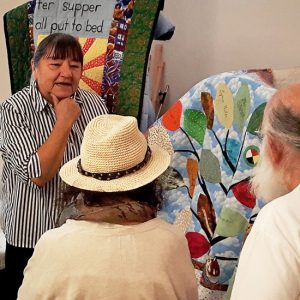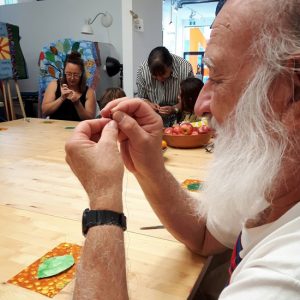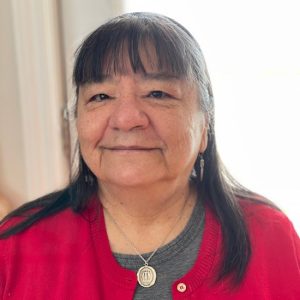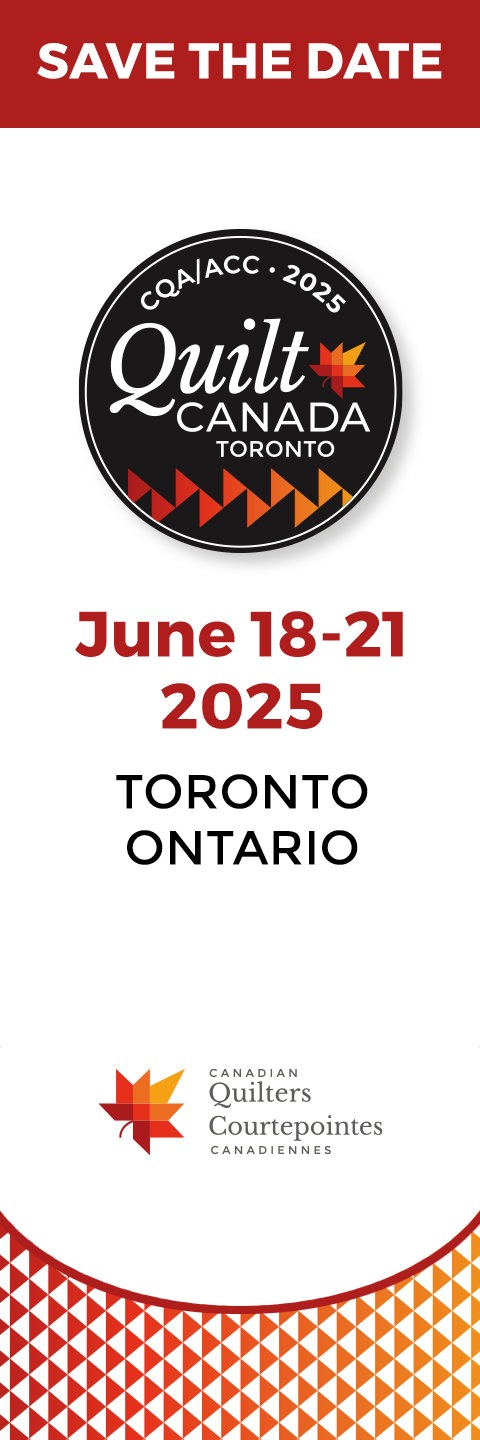My real name is Minaajimo-Kwe; Alice Olsen Williams is my name in English. My mother’s doodem [clan] is the Caribou. Because my father is a Whiteman (born in Oslo, Norway), I was not born into a clan; however, the Martin adopted me into theirs. I was born in Trout Lake, in Northwestern Ontario, the Land of my mother’s people and relations from time before memory, long before Euro colonialism invaded Turtle Island, and have lived for the past 53 years at Curve Lake First Nation just north of Peterborough, ON, where my husband and four children were born and raised. I am a sovereign member of the mighty Anishinaabe nation. This is what I say when I introduce myself at ceremonies. If I’m with friends we have a good little chuckle about that.
I am known for my quilts. As a quiltmaker, my hope is to bring honour to women, as women in many cultures and down through the millennia have made blankets for warmth, comfort and beauty as expressions of love for their families, households, relations, ceremonies and gifts.
I did not always twig to quilts and quilt making. The first time I looked at a quilt carefully I was dismayed to see all those tiny, tiny stitches and wondered how anyone could even imagine doing all that work. I had done a lot of beadwork in the past which requires working with minute beads and small stitches, but those projects are relatively small and it is easy to see an end to them. But quilts – they are so big! How could anyone believe that there would be an end to it?! Those feelings of dread overwhelmed me and I would actually turn and walk away from a quilt display whenever I happened to come across one. The thought of all that work made me shudder.
All of my life I have loved fabric. My mom was poor when we were small but she managed to possess a few pieces of fabric. She made her own blouses and dresses and sewed clothes for her six children. I remember her gazing at her fabrics, fondly touching them and saying how she loved the different designs and colours. That must have rubbed off on me. As early as my high school days I began buying little bits and pieces however, I couldn’t buy a lot until after I was married and settled in my own home, for I had nowhere to store it.
By the time my firstborn, a daughter, was one year old, I had accumulated quite a little pile. I made some of my clothes, but I never liked the way they looked on me. I hated making curtains, placemats and other household items, so I made my daughter little dresses; I made so many that she didn’t wear even a tenth of them. This was so discouraging. I just couldn’t find a way to use my beautiful fabric.
Then one day in July, 1980 – I was 35 and had four children – a friend excitedly mentioned that she had seen a quilt course advertised and suggested that we sign up for it. I really wasn’t interested, but she was so enthusiastic about it that I didn’t want to rain on her parade. “Besides,” I thought, “it won’t hurt me. It’s such a short time commitment – just two hours, one day a week for four weeks. How can anyone be upset about eight hours?”
So, Debbie and I went to our first quilting class. I remember sitting around a big table and being handed a small bag with a few pieces of matching fabric and the picture and templates for the Honey Bee block. The minute I handled them I began to get excited! I couldn’t wait to get started. I always credit that moment as the time I discovered what I could do with all of my material. Quilting was the exciting and meaningful way for me to use it.
For the next four years, I cut, pieced and quilted conventional quilts, took the occasional course and joined local guilds. I made blocks that were developed, and continue to be evolved by, women and their descendants who came to this Land from across the ocean including Log Cabin, Shoo Fly, Friendship Star and Grandmother’s Fan. I can’t explain why, but I enjoy these ordinary blocks. They appeal to me. The way they can be made to look so different just by changing some (or all) of the colours inspires me, not to mention that giving different shapes a mere twist or turn can produce a completely different effect, and sometimes, even a new block. I love putting many colours and shapes together to make something new.
 Turtle in Muddy Waters hangs in the Giizhigaatig Room of Trent University’s Bata Library.
Turtle in Muddy Waters hangs in the Giizhigaatig Room of Trent University’s Bata Library.
During this time, I kept thinking, “I really love this. It excites me, but it also keeps me on an even keel. I love this so much that it’s going to be the me part of the rest of my life.” It was not something I was going to do whenever I found a bit of spare time or when I could fit it in somewhere during my days. It meant that most other things in my life were going to come second. Quilting was going to be my most meaningful connection to Life with everything else squeezed in around it – housekeeping, meals, soaps, shopping, laundry. I was going to treat quilting like eating: you enjoy it and you have to do it.
Because I gave so much of my life to quilting, I looked for ways to answer the question, “How am I going to put who/what I am into my quilts so that people will know that a First Nations woman made them?” I realized that I had to start from me: “Who am I and what has made me who I am?”
My life experiences have helped make me who I am, shaped by an Anishinaabe mother and a white father. I was treated as Anishinaabe by white people but I was not Indian under the law, therefore, while I was raised among Anishinaabe relatives, I had to attend provincial schools. And, because our home was in the bush, I had to board in private white homes, much like many First Nations children when the state and Children’s Aid swept them away from their parents. I won’t go into the dreadful ways that my cultural roots and self esteem were severed and shattered during my school years, however, I do want to acknowledge that I was often treated much better than many Anishinaabeg because white people bestowed some “white skin privilege” on me.
 Alice helps women from the Truth and Reconciliation Commission, Bobcaygeon make a banner to increase awareness of residential schools, a horrible and painful chapter in Canadian history.
Alice helps women from the Truth and Reconciliation Commission, Bobcaygeon make a banner to increase awareness of residential schools, a horrible and painful chapter in Canadian history.
I am grateful for my dual heritage, for how it has shaped my life, my thinking and how I interpret the world. From my mother, I am connected to the sacred spirit and life of this Land and to the people and life who came before us. She gave me the core of my being, the Anishinaabe way. Traditionally, women rearing their daughters and sons have a more intimate relationship with their children than do men, passing down cultural norms and values. Because my mother raised me during my most formative years, the essence of my being is experienced in terms of the Anishinaabeg.
My father gave me the traditions of the white culture, making it possible to live more easily in the milieu of the dominant society. Because I would one day have to go to school and live outside of the Anishinaabe ways (which was essentially communal and non-competitive) my parents prepared me to live in a racist, capitalist society. My father taught me the norms and values to adopt and adapt to so that it would be easier to gain acceptance. I perceive these cultural traits as clothing: they cover up my Anishinaabe self so white people are able to more easily accept me and I can succeed or make it in their world.
With quilting, I wanted to acknowledge my dual heritage, but how? What form would it take? What images would I use? This occupied me for the next couple of years.

Because so many First Nations people are of mixed blood and want to retain our connection to the Land and all the relations who gave us being, I wanted my quilts to represent and acknowledge my dual heritage. At the centre of my designs I placed an Anishinaabe art form, such as those by artists like Onsaawaabiko Binesi (Norval Morisseau). If I didn’t have one, I featured birds, animals or beings that figure significantly in Anishinaabe life and stories. That’s how I show the heritage my mother gave to me: Anishinaabe Kwe. It also honours the fact that we First Nations people are given this great and sacred Turtle Island to love, respect, and care for – this is our homeland. I placed traditional quilt blocks either as a decoration above and below the central theme or as a frame around it, sometimes both, to illustrate the heritage my father gave me.
As I worked, I began to realize that it was the Anishinaabe men’s art form that I was using but I wanted to use that of women and tell the world about them; after all, I am Anishinaabe Kwe. But I couldn’t define it and it left me feeling embarrassed, questioning why I didn’t know. Creation has given that men and women see and interpret things differently. How come I had missed the boat?
 Students learning to thread a needle, knot their threads and tie them off in one of Alice’s workshops. They were very proud of their accomplishments and so happy to be able to keep their projects and take them home.
Students learning to thread a needle, knot their threads and tie them off in one of Alice’s workshops. They were very proud of their accomplishments and so happy to be able to keep their projects and take them home.
How was I going to find out without asking someone, exposing my ignorance and showing that I didn’t know a great part of who I was? It should have been an intuitive part of my being, not something I was consciously looking for! But the desire to know was stronger than my fear and trepidation. I wanted to ask an Anishinaabe woman but suspected that they were so connected to their Anishinaabe-wisiwin (ways) that they wouldn’t understand why I would want to compartmentalize everything in my life (like white people do). When one is grounded in her culture, one doesn’t have any empty spaces. Also, my being reasonably well-schooled made me think the elders couldn’t possibly know what I was talking about. My dilemma was that I would probably have to ask a man.
During a visit from an internationally recognized Anishinaabe artist and language speaker from Pikangikum, Panned (Fred Suggashi) I found the opportunity to ask my question. I made myself jump in with both feet. Without hesitation he answered, “Oh, that’s easy.” Instantly I fearfully thought, “Ohmygosh! If it’s that easy, how come I don’t know? Here he is a man and he knows. What’s wrong with me?” As nonchalantly as I could I asked, “Well, how would you explain it?” Just as nonchalantly he answered, “Floral and geometric.”
Floral and geometric. I was stunned! Why didn’t I know that when I was looking at Anishinaabe art I was looking at our men’s art forms, thinking only in terms of our men’s work?
Many of us are influenced, schooled and socialized in a Christian, capitalist value system where women and their roles and contributions are negated, devalued and not even acknowledged, so it was little wonder that I wasn’t aware that distinct Anishinaabe-Kwe cultural traits and behaviours existed. The patriarchal social structure profiles male culture as if it were the only valid way of thought, language, action and life. That is why I had to dig so hard to find what was right in front of me. Again, it’s in my genes that I would know these things, but women things are learned out of our consciousness, both individually and collectively. I realized that all my life I had watched my mother do her art in different media – beads, embroidery floss, colourful threads and textures, birch bark, fur, roots, skins – often using floral and geometric designs. Despite having done beadwork using geometric designs and teaching it to my children, I never realized that this was women’s art form.
I was overjoyed to finally have a handle on it. I started to make the centres of my quilts floral, taking the designs from beadwork, quillwork, embroidery, birch bark biting and moose hair tufting, integrating Anishinaabe women’s art forms and showing the world that this is one of our Life and Artways.
I am thankful to Debbie Jacobs for dragging me to that first quilt course. I am also thankful for the heritage and skills handed down by my parents. My children have helped me in many ways as well but one of their biggest contributions is that they did the household chores, allowing me to spend more time and energy on my art. Even though my grandchildren are still small, they too inspire me and give me great joy. I can’t list all the ways my husband has helped me, but his greatest gift is meeting a lot of my construction needs, like making shelves and storage space. Because I don’t like the way I draw, he and our son Keesic have helped me draft some of the images I transfer onto fabric.
Norman Knott, a well-known artist from Curve Lake, was the one who first shared his Anishinaabe art forms with me. Because of his kindness and willingness to share I was able to make a beginning in the distinctive way that I do my work. I hope that, through my quilting, I have been able to make a positive and significant contribution to the understanding of Anishinaabe ways and how we see life, for in the end, this is the only way the Earth and all Life can be saved.
Nicaniganaa, all my relations!
 Alice Olsen Williams has made her home at Curve Lake First Nation, on the Territory of the Michi Saagiig Anishinaabeg. She honours the ancestors who have looked after, loved and stewarded this sacred land from time beyond memory.
Alice Olsen Williams has made her home at Curve Lake First Nation, on the Territory of the Michi Saagiig Anishinaabeg. She honours the ancestors who have looked after, loved and stewarded this sacred land from time beyond memory.


